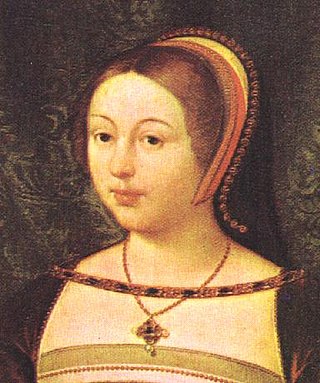Related Research Articles

Margaret Tudor was Queen of Scotland from 1503 until 1513 by marriage to King James IV. She then served as regent of Scotland during her son's minority, and fought to extend her regency. Margaret was the eldest daughter and second child of King Henry VII of England and Elizabeth of York, and the elder sister of King Henry VIII of England. By her line, the House of Stuart eventually acceded to the throne of England and Ireland, in addition to Scotland.

The Verney family purchased the manor of Middle Claydon in Buckinghamshire, England, in the 1460s and still resides there today at the manor house known as Claydon House. This family had been seated previously at Fleetmarston in Buckinghamshire then at Pendley in Hertfordshire. It is not to be confused with the unrelated but also ancient and prominent Verney family of Compton Verney in Warwickshire.

Alexander Elphinstone, 1st Lord Elphinstone was a Scottish peer. He was the son of Sir John Elphinstone of that ilk and of Pittendreich.
Robert Barton of Over Barnton was a Scottish landowner, merchant, sailor and politician. He served as Comptroller, Master of the Mint and Lord High Treasurer to James V of Scotland.

Of James Dog or, more fully, Of James Dog, Kepair of the Quenis Wardrop is a poem of William Dunbar in which the poet complains to Queen Margaret Tudor of Scotland about the keeper of her wardrobe, James Dog.

Ellen or Elen More was an African servant at the Scottish royal court. She probably arrived in Scotland in the company of a Portuguese man with imported animals. There are records of clothing and gifts given to her, although her roles and status are unclear. Some recent scholarship suggests she was enslaved, and her arrival in Scotland can be linked indirectly with the slave trade. She is associated with a racist poem by William Dunbar, and may have performed in Edinburgh as the "Black Lady" at royal tournaments in 1507 and 1508.
Jerome, Hieronimo, or Girolamo Frescobaldi (1444–1517) was an Italian financier and textile merchant based in Bruges. He supplied luxury goods to the Scottish court and was described as a "very good friend to the King of Scots". The Frescobaldi family and company, based in Florence, were involved in artistic commissions in England and Scotland. Jerome Frescobaldi was involved in the wool trade with Tommaso Portinari and his sons, and marketed spices obtained by Portuguese traders.
James Hommyll, was a wealthy merchant in Edinburgh.

Andrew Aytoun, was a Scottish soldier and engineer, and captain of Stirling Castle.

John Mosman was an apothecary at the Scottish court.
John Oliphant, 2nd Lord Oliphant was a Scottish landowner.
Elizabeth Barlay or Barlow was an English lady in waiting to Margaret Tudor the wife of James IV of Scotland.
William Foular was a Scottish apothecary who served the Scottish court.

Robert Spittell or Spittall or Spittale was a Scottish tailor who served Margaret Tudor, queen consort of James IV of Scotland.

Eleanor or Alianor Verney was an English courtier who travelled to Scotland with Margaret Tudor in 1503.

Several documents list the jewels of Margaret Tudor, daughter of Henry VII of England and Elizabeth of York. Margaret married James IV of Scotland in 1503.
Ane Dance in the Quenis Chalmer or A dance in the Queen's chamber is a humorous or satiric Scots poem by William Dunbar.

The More Taubronar was a musician of African origin at the court of James IV of Scotland and his wife Margaret Tudor. His name is unknown. A "taubron" was a kind of drum, the word is related to the modern form "tabor". The word "More" or "Moryen" was used for people of African origin at the Scottish court. Archival records credit the More Taubronar as the producer of a costumed dance or masque performed at the Scottish royal court in 1505.

Matthew Auchinleck or Matho Auchlek was a Scottish goldsmith who worked for James IV of Scotland and Margaret Tudor.

Margaret Dennet was an English servant of Margaret Tudor, the wife of James IV of Scotland, and the owner of lands near Inverness.
References
- ↑ Henry Ellis, Privy Purse Expenses of Elizabeth of York (London, 1830), p. 203.
- ↑ Henry Ellis, Privy Purse Expenses of Elizabeth of York (London, 1830), p. 99.
- ↑ Henry Ellis, Privy Purse Expenses of Elizabeth of York (London, 1830), p. 110.
- ↑ Michelle Beer, Queenship at the Renaissance Courts of Britain (Woodbridge, 2018), pp. 41-3.
- ↑ James Balfour Paul, Accounts of the Treasurer of Scotland, 1506-1507, vol. 3 (Edinburgh, 1901), pp. xciv-xcv: Calendar of Documents relating to Scotland, vol. 4, no. 1680.
- ↑ James Balfour Paul, Accounts of the Treasurer of Scotland, 1506-1507, vol. 3 (Edinburgh, 1901), pp. cii, 120, 123, 325.
- ↑ James Balfour Paul, Accounts of the Treasurer of Scotland, 1506-1507, vol. 3 (Edinburgh, 1901), p. 360.
- ↑ James Balfour Paul, Accounts of the Treasurer of Scotland, 1500-1504, vol. 2 (Edinburgh, 1900), p. 442.